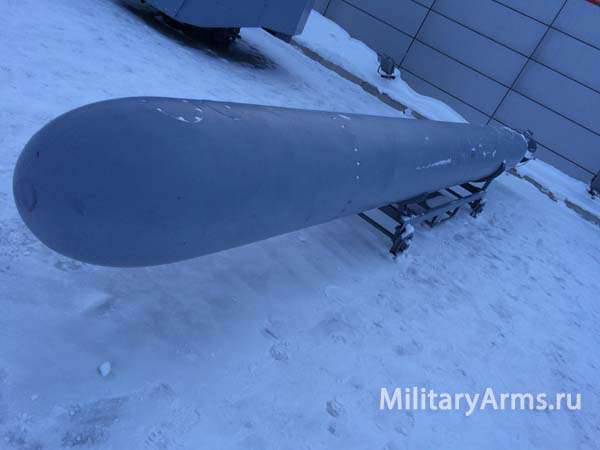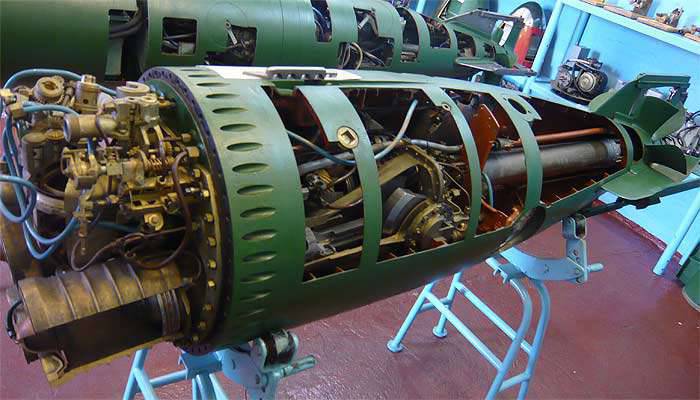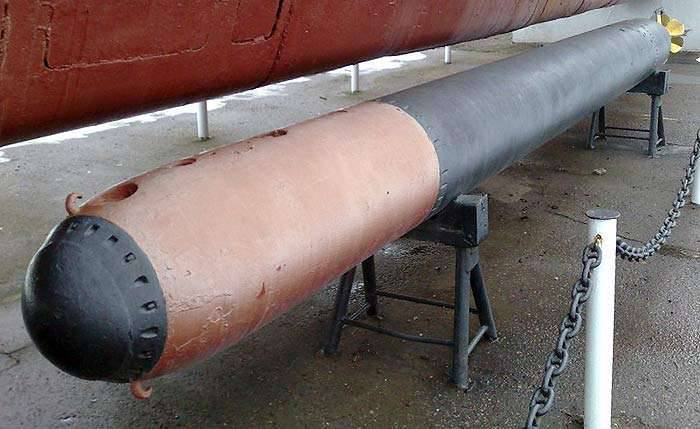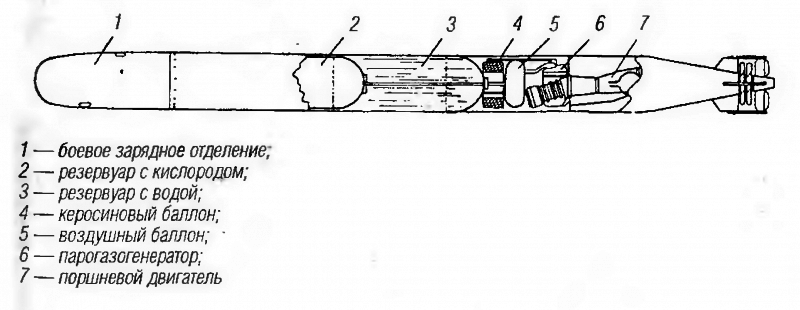Torpedo 53-56 and its modifications
In the late forties and the early fifties, Soviet experts analyzed the captured German documentation, and also conducted their own research. On the basis of their own and borrowed experience, as well as using ready-made units, new types of torpedo weapons were created. It is this approach, in particular, has allowed to improve the existing electric torpedoes, as well as create the first domestic torpedo with a homing system. One of the main areas of work at the same time was the creation of new power plants with enhanced performance.
Back in the mid-forties, shortly after the end of the Great Patriotic War, the specialists of the Research Mine Research and Torpedo Institute (NIMTI) took up the theme of oxygen heat engines. Such power plants were a further development of existing combined-cycle machines and had to differ from them by some features. In particular, the use of pure oxygen instead of compressed air made it possible to eliminate the release of the vapor-gas mixture, which forms a trace of bubbles on the surface of the water. Thus, the oxygen engine, like the electric one, made it possible to create a new traceless torpedo, which did not reveal its location and did not unmask the carrier submarine.

Torpedo 53-56В - outwardly no different from 53-56 KITI. Photo Militaryarms.ru
Around the late forties or early fifties in NIMTI a preliminary draft of a promising torpedo with a new power plant was developed. This project passed a series of necessary checks, after which an experienced torpedo of the 533 mm caliber was manufactured. The prototype was tested, the results of which were determined further development of the existing project. Shortly after the completion of this stage of work, the project was transferred to the design office of the plant No. XXUMX (formerly “Red Progress”, Tokmak). Further development of the new project was carried out precisely by this organization with some assistance from the relevant institutions. The project of a promising oxygen torpedo has received the symbol “Item 175”. AB was appointed chief designer. Topolyansky.
Work on the new project took several years and lasted until the mid-fifties. During this time, the main issues relating to the design of the power plant were resolved, and the proposed technical solutions were also checked. By the middle of the decade, the project was ready for assembly and testing of experienced torpedoes. According to reports, the development of a new weapons Difficult because of the difficulties with the development of a new type of engine. In this case, the existing product was taken as the basis for the car of the new torpedo. The oxygen heat engine was created on the basis of the steam-gas torpedo machine 53-51. Despite the use of ready-made units, the transfer of the engine to a new oxidizer was associated with certain problems.
The first version of the 227 Product was supposed to be a “traditional” straight torpedo without homing systems. It was assumed the use of an oxygen heat engine that provides movement without a trace on the water. Thus, in terms of design, the new torpedo could be considered a recycled version of the existing weapons of previous models.
Torpedo new type received a standard cylindrical body with a hemispherical head and a tapered tail fairing. On the latter, an X-shaped structure with rudders was provided, inside which two coaxial propellers were placed. The layout of the internal volumes was also traditional. A fighting compartment with an explosive charge and a fuse was placed at the head of the hull, behind them was a large tank for compressed oxygen. The aft compartment contained tanks for kerosene, fresh water and oil, as well as a steam and gas generator, engine and control equipment. The torpedo had a caliber of 53 cm and a total length of 7,45 m. The weight of the product assembly reached 1900 kg.
"The product 227" received a fighting compartment with 400-kg charge. To undermine the charge, it was proposed to use a new non-contact optical fuse type HB-57. This product was supposed to initiate the undermining of the warhead during the passage of a torpedo at a short distance from the target. In response to changes in the light falling on the sensor, the fuse had to detect the target and give a command to undermine it. With this, small mistakes were compensated.
In the stern compartment of the torpedo there was an oxygen heat engine created based on the 53-51 torpedo machine. This device included a steam and gas generator and a piston machine with two horizontal cylinders connected to a crank mechanism and two coaxial propellers. During operation, the steam and gas generator of the engine had to burn kerosene (oxygen was used as an oxidizer), and then mix the resulting gas with fresh water. The resulting vapor-gas mixture was fed into the cylinders and interacted with the pistons, rotating the propeller shafts.
The applied powerplant allowed the "277 Product" to reach speeds up to 50 units. If necessary, it was possible to set a different mode of operation of the machine, in which the speed reached only 40 nodes. In the first mode, the range was 8 km, on the second - up to 13 km.
For the torpedo "Product 227" was developed a new equipment, responsible for keeping at a given course and at the right depth. The principles of its work, according to available data, remained the same. The hydrostat was responsible for controlling the depth, and a gyroscopic device was used to track the course change. When determining deviations from the desired course, these devices issued commands to the steering cars, which returned the torpedo to the correct position.
In 1955-56, Plant No. 175 completed the design work, after which it produced experienced torpedoes of a new type. Tests ended successfully, after which the torpedo was adopted. In accordance with the nomenclature adopted at that time, the product received a new designation 53-56 - torpedo caliber 53 cm, arr. 1956 d. In addition, the name 53-56 KIT (“Oxygen Torpedo”) is found, referring to the first modification of the product. Serial production of such weapons was entrusted to the plant to them. CM. Kirov (Alma-Ata).
According to some reports, the full-fledged mass production of new torpedoes did not begin immediately. By the time the serial torpedoes began to be assembled, the 53-56 project retained some of the flaws that had to be eliminated after official adoption. All these problems affected the main characteristics of the weapon, as well as its reliability. It took some time to correct the deficiencies and master the production of efficient weapons, after which the delivery of torpedoes to the fleet started. The surface ships and submarines of various types equipped with 53-cm torpedo tubes became the carriers of new torpedoes.
Torpedo 53-56 differed from the previous domestic weapons in its class higher performance, provided the new power plant. For this reason, it was decided to leave the basic version of the 53-56 KIT only for arming the Soviet fleet. For export, in turn, it was proposed to supply products of a new modification. According to others, it was proposed to develop a new project due to technical problems with existing weapons. The development of a new version of weapons started in the early sixties in the design bureau of the plant number XXUMX. This project has received the designation 175-53В or "Item 56".

Piston engine used on 53-51 and 53-56 torpedoes of various modifications. Photo Militaryrussia.ru
The base project 53-56, as well as the existing combined-cycle torpedoes 53-56ПМ and 53-39 were taken as the basis for the 53-51В product. Almost the entire structure was borrowed from the oxygen torpedo, with the exception of some elements of the power plant, which were taken from the 53-39PM and 53-51. So, instead of an oxygen tank, an 647-liter compressed air tank was installed. Other containers remained in place. As a result, a new torpedo with a steam-gas heat engine appeared, which, unlike the oxygen one, was no longer a secret, and was also tested in practice. The consequence of this approach to design was a slight reduction in performance.
Torpedo 53-56В differed from the oxygen prototype with a total length, increased to 7,74 m. Caliber and weight, including the mass of the fighting compartment, remained the same. The torpedo speed was 40 or 50 nodes. Due to the lower efficiency of the combined-cycle engine compared to oxygen, the maximum range of the new torpedo was only 8 km. At maximum speed range was reduced by half.
After passing all the necessary tests, the 53-56B torpedo was put into service and put into mass production. In addition, it was offered to foreign customers. Exact information about the supply of 53-56In foreign countries are not available. According to some reports, similar weapons were ordered by India, but other sources mention that torpedoes of other modifications were supplied to the Indian Navy.
There is information about the use of torpedoes 53-56V the navy of the Soviet Union. In our country, this weapon was used for training purposes and was considered as a cheap analogue of the oxygen 53-56 KIT. Thus, the fleet was given the opportunity to train personnel and conduct combat training activities without consuming relatively expensive torpedoes. In addition, in some sources it is mentioned that the new combined-cycle torpedo differed from the oxygen prototype in greater reliability, which could also affect the approaches to the operation of weapons.
In the mid-sixties, the Yugoslav naval forces ordered the Soviet Union to develop a modification of the 53-56B torpedo with a homing system. The development of such weapons was entrusted to SRI-400 (now the Central Research Institute "Gidropribor"). This project received the designation "Product 274" or 53-56BA.

Torpedo 53-56BA. Clearly visible mounting circuit cover hydroacoustic antenna. Photo Militaryrussia.ru
To fulfill the order of a friendly state, we had to significantly rework the design of the base product. Thus, the fighting compartment was reduced, and in the released volume they installed a homing system similar to that used on other torpedoes of the time. The head fairing of the case received a straightened front part, on which a hydroacoustic antenna with several receivers was mounted. To reduce the level of interference, the antenna was covered with an additional light fairing. According to reports, the homing system provided a search for a target only in one plane and reacted to the target at a distance of up to 600 m. Thus, the torpedo could only be used against surface ships.
The 53-56BA self-guided torpedo was equipped with a reduced fighting compartment with a 260 kg weight. Due to this and some other improvements, the total weight of the weapon was reduced to 1875 kg. To ensure the operation of homing and reduce the noise of its own units, the power of the main machine was reduced, which led to a reduction in speed. The “274 product” could go to the target at a node speed of 29 or 32. In this case, the range was 11 or 10 km, respectively.
Adaptation of the existing homing systems to installation on a steam-gas torpedo was associated with a number of noticeable problems. Because of this, in particular, the deadlines for delivery of the finished product to the customer in the face of the Navy of Yugoslavia shifted several times. After a number of difficulties, work was completed only in 1966. Then the customer sent the first batch of serial torpedoes. Subsequently, the 53-56BA products were ordered by India. There is also information about the supply of similar torpedoes of the Soviet Navy.
The first torpedo of the 53-56 family was put into service in the mid-fifties. In the future, new modifications of this weapon, differing in the type of power plant and the use of homing. The weapons of all three modifications were delivered to the domestic fleet, and products with the letters “B” and “BA” were also sent for export. It is known that the production of such torpedoes lasted until at least the mid-seventies. In service with the Soviet Navy, they remained until the beginning or mid-eighties.
When developing torpedoes of the 53-56 family, a number of important design problems were solved, which led to the development of new technologies and the emergence of weapons with high performance. Thus, the basic product of the 53-56 KIT line remained in the history of domestic mine-torpedo armament as the first production torpedo with an oxygen heat engine. In the future, similar power plants were used on a number of other torpedoes, some of which are still in use. The last torpedo of the family, 53-56BA, also took an interesting place in history. It was the last domestic torpedo equipped with a steam-gas engine. By the mid-sixties, when it was developed, such power plants were already considered obsolete. Subsequently, the torpedo armament designers switched to newer and more sophisticated systems, the creation of which actively used developments under the 53-36 KIT project.
Based on:
http://wunderwafe.ru/
http://submarine-at-war.ru/
http://militaryarms.ru/
http://militaryrussia.ru/blog/topic-475.html
Shirokorad A.B. Weapons of the domestic fleet. 1945-2000. - Minsk: “Harvest”, 2001
Gusev R.A. Such is the torpedo life. - S.-PB.: Willow, 2003

Information